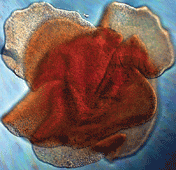
 |
||
The Yale Alumni Magazine is owned and operated by Yale Alumni Publications, Inc., a nonprofit corporation independent of Yale University. The content of the magazine and its website is the responsibility of the editors and does not necessarily reflect the views of Yale or its officers. |
|
The pinhead-sized creatures called Trichoplax adhaerens (one appears below) were discovered clinging to the walls of a saltwater aquarium in the 1880s. The simple, amoeba-like organism, known as a placazoan, is believed to be among the first multicellular animals to evolve, about 600 million years ago.
Yet
their DNA is surprisingly complex—and familiar. Recently, molecular biologist
Stephen L. Dellaporta and an international group of collaborators sequenced the T. adhaerens genome. (The study appeared in the August 21 early online edition of Nature.) Although the genome is a fraction
the size of our own, with 98 million base pairs versus 3 billion, it has many
of the sequences for key genetic pathways and regulatory processes that are
common to all animals. In fact, said Dellaporta, “Trichoplax shares over 80 percent of its genes
with humans.” |
|
|
|
|
|
|
|
|
©1992–2012, Yale Alumni Publications, Inc. All rights reserved. Yale Alumni Magazine, P.O. Box 1905, New Haven, CT 06509-1905, USA. yam@yale.edu |
||
